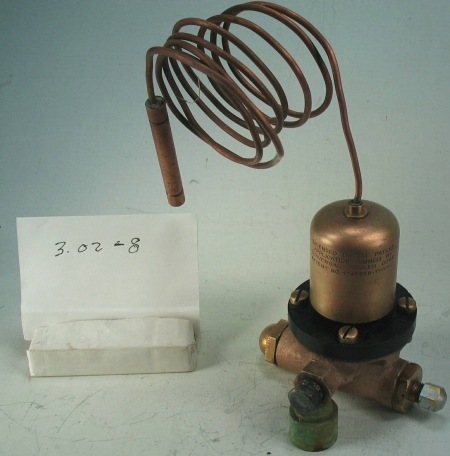Refrigerant Flow Controls – Commercial
An early, compact, adjustable thermostatic expansion valve made by arguably the leader in expansion valve technology of the period, beautifully crafted with brass body, “high tech.” Bakelite cover plate, similar to item ID #186 and #201, but differently fitted, this model licensed under patent to Universal Cooler Corp.; part of an impressive stable of valves, patterned off Detroit Lubricator’s earlier, Model 670, automatic expansion valve; Manufacturer’s name given here as American Radiator, Model 671- M, Series-1, circa 1936.
Technical Significance:
This valve, compact and elegant in design and construction, in contrast to similar valves produced by Frigidaire of the period [See ID # 184 and 185], was the work of a relative new comer in the refrigeration field, Detroit Lubricator. It would prove to be a significant marker of the changing times.
The age of the component parts, systems, specialty manufacturer had arrived, here as in the automotive field. In the future brand name system and equipment suppliers to the HVACR market would concentrate on system development, production and marketing. Increasingly, component technologies would be out sourced to specialty companies with the engineering know how and needed production capacities.
The valve would stand as a wonderful icon of the early years in TX valve development, as the industry searched for an alternative to the costly and often troublesome, liquid refrigerant, float valve technology of the mid 1920, and 30’s.
This artifact of history tells the many stories of early adoption of this particular refrigerant flow control technology. After a brief flurry of excitement over the use of costly and delicate float operated devices, as a more efficient means of flow control, industry engineers would return to the automatic expansion valve in the early 30’s. But for many medium and larger applications the automatic expansion valve would give way to the more elegant and efficient thermostatic valve for use in a new generation of “dry evaporator” applications.
Industrial Significance:
Carrying the name American Radiator, the exact genealogy of this device remains to be determined, including its relationship to Detroit Lubricator,
The range of configurations in which this valve was produced was a marker of an increasingly diverse market place for thermostatic expansion valve technology, with different fitments to meet the different requirements of original equipment manufacturers. It was an industry in its first period of rapid growth. See also ID # 186, 201, 202
The valve is also an industry marker of the early entry of Universal Cooler, destined to be a major new player in the growing commercial refrigeration field.


